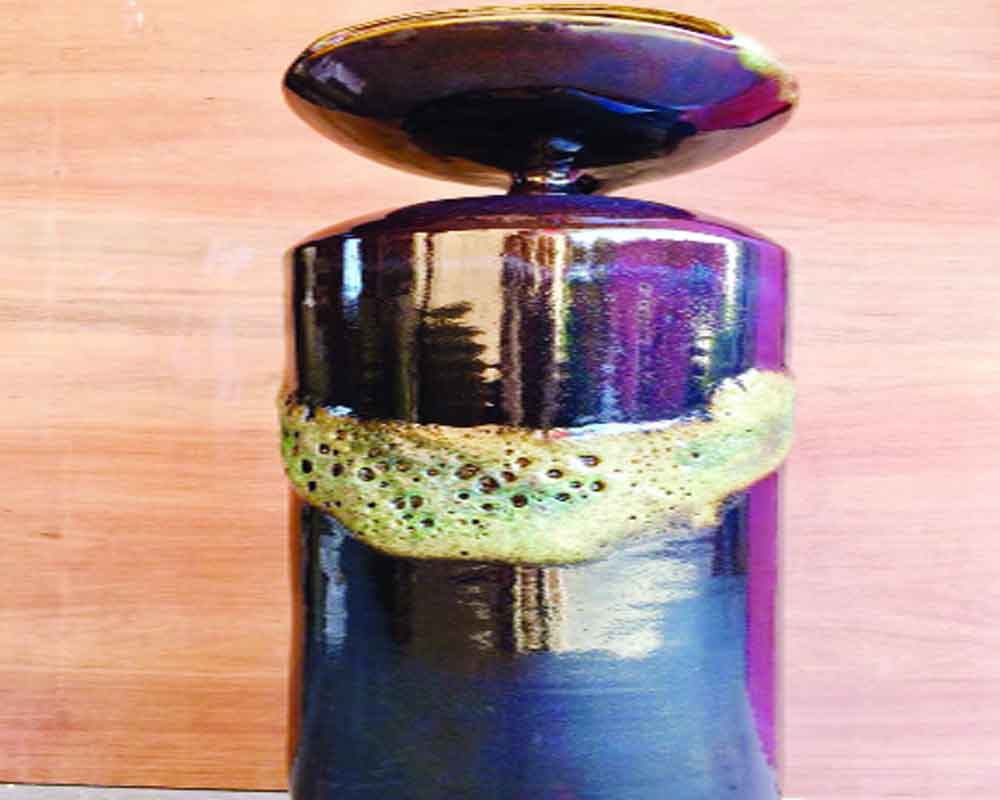Tales about disparate homes and civilisations come alive in Artist Keshari Nandan’s tall cylindrical pots with small mouths. The Artist has been known for his love of nature and pottery skills, which he has pushed further with his latest stoneware collection. “I am developing new techniques to recreate the magic of the old potter’s wheel by using traditional motifs and shapes but I add a modern touch, without losing the established aesthetic.” The Rajasthan dweller and AIFACS award-winning artist’s experiments with stoneware go back more than 20 years and are a testimony to his perseverance at a wood-fired kiln in his studio near the mines in Rajasthan.
Understanding stoneware
The particles, pores and textural terrain that we see on his pots, platters and tree symbolisms are reminiscent of stories of the accidental, the deliberate and the perfection that must go into the blending of glazes and precision in firing techniques that he has practised over the years.
The first thing that comes to our minds is the difference between stoneware and earthenware. It is much less porous than earthenware, about one to five per cent. It is stronger too, in some ways than earthenware.
Keshari says that everything in stoneware is about the finality and understanding of the recipe and ingredients. Stoneware recipes usually have a combination of fire clays, ball clays (and/or kaolin), quartz and feldspar. In vitrified bodies the larger grains of quartz and other refractory particles remain unmelted while the clays go into solution in the feldspar glass and transform into mineral forms that impart rigidity to the mass.
History tells us that stoneware was first developed in the Indus Valley Civilisation and in China around 2,000 years ago. However, we see that stoneware in studio pottery has taken over the West and there are a number of potters creating avant grade works. Keshari’s tall cylindrical pots with small mouths go back in time and tell us tales about different homes and civilisations.
Glazes and wood firing
The most telling testimony in these works is the persistent quality and finish of the glazes that Keshari uses. The glaze does not merely lie on the surface but rather melts at the interface and therein lies the key to the amalgam. Keshari’s stoneware and clay platter is a cynosure of all eyes. It talks to us about the painstaking accuracy needed for stoneware recipes. He combines the density of the tenmaku glaze with crackle glaze to create a platter that unveils lunar modulations.
In his taller cylindrical pots that echo earth songs, he uses the tenmaku glaze with crater glaze and wood fires at a temperature of 1,260 degree centigrade. In yet another set of lighter palette ensembles, he uses stoneware glaze and white matt with crater glaze and wood fires them. His unglazed stoneware vase is a delightful tall urn like creation with rough hewn clumps that can go back to the days of Mohenjo Daro and Harappa civilisations.
Materials in stoneware
Stoneware is noted for its excellent working properties. The workability of these materials results from the fact that their recipe does not need to contain a lot of plasticity-reducing feldspar or silica (natural clay materials usually contain their own fluxes). Stoneware bodies often contain particulates that produce gases on decomposition that can cause bloating if the body is fired to near zero porosity. They contain refractory particles that do not melt during firing. They form a fired skeletal structure with voids between the particles and in these the feldspars melt to bond and densify the structure. These works are collectibles that must be used as punctuations in spaces.
Writer: U Nair
Courtesy: The Pioneer








 OpinionExpress.In
OpinionExpress.In















Comments (0)